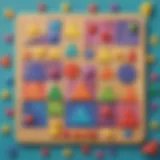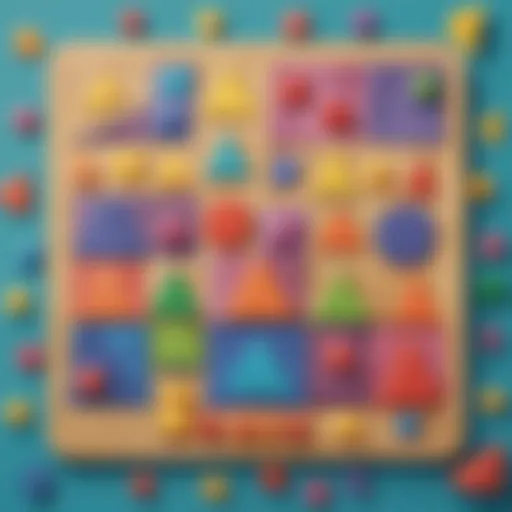Understanding Distance: Types, Measurements, and Significance


Intro
Distance is a basic but profound concept. Everyone encounters it in their daily lives. From measuring how far it is to the store to understanding mathematical distances on a graph. Distance can be geographical, mathematical, or even conceptual. In this article, we will explore each of these forms of distance. We will also look at methods of measurement and tools used in various fields.
Distance matters greatly for different reasons. It can help us plan travel or comprehend space in science. Knowing how to measure and understand it enhances comprehension in numerous disciplines. This exploration aims to clarify these different dimensions of distance and provide insights into measuring them accurately.
Creative Activities
Craft Ideas
Engaging in creative activities can enhance understanding of distance. Children can replicate these simple crafting ideas. For instance, creating a scale model can provide insights into geographical distance. They might create a paper map using small objects to represent different locations. This hands-on activity roots the abstract idea of distance into something tangible.
Step-by-Step Guides
- Create a Map: Draw a simple map of your neighborhood, including landmarks.
- Measure Distances: Use a ruler to measure the distance between different objects on the paper.
- Scale Drawing: Choose a scale (for example, 1 cm = 100 m) then re-draw it to further understand proportional distance.
With this simple exercise, children learn about distance visually and practically. It fosters both creativity and logical thinking.
Educational Value
The educational benefits here are significant. Crafting activities often boost critical thinking. Understanding distance via hands-on projects allows children to grasp parameters that are harder to visualize through textbook learning alone. They learn spatial awareness while enjoying the crafting process.
Fun Quizzes
While crafting aids creativity, quizzes reinforce learning effectively. In this section, we explore various quiz topics.
Quiz Topics
Quizzes can cover numerous topics related to distance.
- Definitions of distance
- Different types of distance (geographical, mathematical, conceptual)
- Methods of measuring distance
Question Types
Using diverse question types engages kids, keeping learning fun and dynamic. Some common formats include:
- Multiple choice questions
- True/False statements
- Fill-in-the-blanks
Knowledge Reinforcement
Quizzes assist in solidifying knowledge. As children answer questions, they recall information and clarify doubts, enhancing their understanding. They can track progress and knowledge gaps systematically.
Fact-Based Articles
Fact-based articles are vital for in-depth knowledge. They provide foundational understanding, on what distance entails.
Topics
These articles discuss a range of subjects that support our main theme, creating a broad knowledge base for interested learners.
- Historical methods of measuring distance
- The significance of distance in navigation
- Applications of distance in technology today
Engaging Content
Well-crafted articles present information clearly. Simplifying complex ideas allows learners to gain essentials without feeling overwhelmed. This format invites curiosity while reinforcing knowledge.
Prelims to Distance
Understanding distance paves the way for many essential discussions in our daily lives, whether it involves travel, communication, or logistics. Distance embodies both a physical dimension and a conceptual framework. It represents not just how far apart objects are in space, but also the levels of understanding or connection between ideas. An effective grasp of distance contributes to making informed decisions in various realms.


Defining Distance
Distance can be defined simply as the amount of space between two points. This can apply to physical lengths—like the distance from one city to another—or more abstract forms, such as emotional or intellectual distances.
There are two primary kinds of measures for distance:
- Geographical distance quantifies how far apart locations are in a tangible sense.
- Mathematical distance, often expressed in specific metrics, evaluates the relative position of data points within numerical frameworks.
- Conceptual distance helps in understanding the gap in ideas or understanding between different topics or fields.
Furthermore, distance can be measured using different units inspired by the context of the discussion. For geographical instances, kilometers or miles are commonly employed. In mathematics, concepts like Euclidean distance might rule.
Importance of Understanding Distance
Comprehending distance has practical implications. It is adaptive in shaping everyday experiences. For instance, parents who recognize the geographical distance to schools position their decisions on commuting more effectively. The physical space can impact a child's school choice and daily routines. Similarly, an understanding of conceptual distance in topics, helps educators tailor instructional approaches better.
At societal levels, understanding distances can drive numerous decisions—anything from infrastructural development to trade routes. Proper knowledge influences how resources are allocated and, ultimately, impacts the efficiency of communication in diverse settings.
Understanding distance adequately bridges gaps, making interactions smoother and more efficient.
In sum, mastering the concept of distance arms individuals and communities with tools necessary for better navigation. It opens paths to navigate both space and communication, forming a basis for informed decisions and actions.
Types of Distance
Understanding the different types of distance is crucial for interpreting how we perceive, measure, and interact with the world around us. Recognizing geographical, mathematical, and conceptual distance offers valuable insights into many practical applications. It shapes our daily decisions related to travel, shipping, and even personal communication. Moreover, exploring these variations allows us to analyze each type's unique characteristics and implications for technology and human interaction.
Geographical Distance
Geographical distance refers to the physical space between two locations. It tends to be measured in standard units such as kilometers or miles. This type of distance is significant in fields like geography, urban planning, and transportation. When travelling, geographical distance can affect travel time and costs. For instance, a small geographic distance may invoke different travel times based on route selection, while a long distance dominates travel arrangements requiring nuanced scheduling and resource management.
There are multiple ways to calculate geographical distance which include:
- Direct Measurement: Using a map or global positioning systems (GPS) to determine length.
- Air Travel Estimates: Also known as 'great circle' measurements, this approximates the shortest route between two points on Earth's surface.
- Polyline Calculation: Involving visualization applications where the distance may require tracing along accessible routes.
Using tools such as Google Maps or a generic GPS enables a clearer understanding of geographical distance and plays a significant role in transportation safety and logistics.
Mathematical Distance
Mathematical distance deals with quantifying separation between points within a defined space. It employs metrics that can differ depending on the context. Commonly used metrics include:
- Euclidean Distance: The straight-line distance between two points in a plane.
- Manhattan Distance: A grid-like distance measurement, summing horizontal and vertical distances.
- Hamming Distance: Used in information theory to measure differing characters between strings.
The calculations of these factors are essential in various areas, including data analysis, computer science, and robust network planning. They provide vital information about data clusters and trends, ensuring more informed decisions based on identified patterns.
In graphical representation, mathematical distance is often visualized through simple diagrams making complex ideas more accessible to learners. Visualizing concepts encourages better comprehension of distance-related problems.
Conceptual Distance
Conceptual distance delves into how ideas, beliefs, or principles diverge. This type addresses the gap in understanding or interpretation. Conceptual distance can be crucial in communication, influencing how closely ideas resonate with one another. The greater the conceptual distance, the more potential for misinterpretation or misunderstanding of intent, especially in discussions where differing perspectives arise.
In recognizing the implications of conceptual distance:
- It directly impacts negotiation outcomes when parties have contrasting views.
- Strategic communication, ensuring clarity, aids in reducing conceptual distances.
- Group dynamics underscore the necessity for common understanding to prevent conflict.
Acknowledging varied distances empowers us to manage interactions with a sophistication that promotes successful comprehension in conversations.
Understanding the types of distance is fundamental for effective engagement in our daily lives.
Geographical Distance Explained
Geographical distance refers to the space between two points on the Earth's surface. It is a critical concept because it serves various purposes in our daily lives, particularly in travel, logistics, and urban planning. Understanding geographical distance allows people to estimate travel time and optimize routes, ultimately affecting their decision-making. This section will detail methods for measuring geographical distance, tools utilized in this process, and real-life examples.
Methods of Measuring Geographical Distance


There are several methods to measure geographical distance, each varying in accuracy and practicality:
- Straight-Line Distance: This is the simplest form of measurement. It calculates the shortest path between two points assuming direct travel through space. The distance may not consider actual transportation routes.
- Curvilinear Distance: Involving road or travel distance, this method takes into account the actual paths one would take when traveling, which can be longer than the straight line measurement.
- Great Circle Distance: Used mainly in aviation, this method calculates the shortest distance over the Earth's surface, considering its curvature. It is particularly useful for long-distance journeys.
For precise measurements, it could be beneficial to use coordinates. By utilizing the latitude and longitude of locations, it becomes easier to determine effective distances, especially when comparing numerous locations.
Tools Used in Geographical Distance Measurement
Various tools exist for measuring geographical distance, ranging from simple to complex:
- Maps: Traditional maps provide a visual method for assessing distances using scale bars. They can give a rough estimate but lack precision.
- Online Mapping Platforms: Websites like Google Maps and Bing Maps offer real-time distance calculations. These platforms consider roads, paths, and current traffic conditions, providing accurate and timely data.
- GPS Devices: Global Positioning System devices compute geographical distances efficiently by locating signal—allowing for turn-by-turn navigation that adjusts in real time.
This mixture of traditional and modern tools gives users various options to measure distances effectively depending on their needs and situations.
Examples in Everyday Life
Understanding geographical distance has practical applications that influence many aspects of our daily lives:
- Travel Planning: When planning a trip, it is vital to understand the distance involved for estimating travel time. For instance, knowing that a 300-mile drive takes roughly five hours can help frame expectations.
- Delivery Services: Companies like Amazon calculate distances to ensure timely deliveries. Measuring geographical distance helps them optimize their routing methods.
- Urban Development: City planners utilize distance measurements to decide where to place new features like schools and parks. This ensures accessibility for the communities.
Mathematical Distance: Concepts and Applications
Mathematical distance forms a crucial part of understanding how distances influence various scenarios in daily life and scientific contexts. This concept allows us to quantify space in a clear manner. Understanding different metrics of mathematical distance can lead to better decision-making. It can also have applications across many domains including computer science, data analysis, and even art. By recognizing how and when to apply these measurements, one can appreciate the relationships between points in either mathematical or physical contexts.
Different Metrics for Mathematical Distance
Mathematical distance is not merely one singular measurement. There are various metrics when we discuss distance mathematically. Here are some commonly used metrics:
- Euclidean Distance: This is the straight-line distance calculated using the Pythagorean theorem in a Cartesian space. In three-dimensional space, it is found using the formula:$$d = \sqrt(x_2 - x_1)^2 + (y_2 - y_1)^2 + (z_2 - z_1)^2$$
- Manhattan Distance: Sometimes called
Conceptual Distance
Understanding conceptual distance requires a viewing lens that spans beyond pens and paper; it involves the many layers through which people comprehend and interpret reality. Conceptual distance is fundamental in diverse fields like psychology, sociology, and communication, asserting its importance by providing insight into how individuals assimilate information and connect with ideas.
Understanding Conceptual Distance
Conceptual distance refers to the perceived space between people’s understanding of ideas and thoughts. Yhis span is not measured in traditional metrics like kilometers or miles, but instead is influenced by people’s backgrounds, experiences, and how reeiant they are to views presented.
Elements calciumtronique of conceptual distance include:
- Cognitive Framework: Individual mental structure plays a significant role. Familiar concepts are easier to grasp, thereby shortening conceptual distance. When an unfamiliar idea clashes with established knowledge, the gap widens.
- Contextual Relevance: The situation in which a concept is introduced matters. A direct correlation to someone's experiences can increase understanding.
- Cultural Factors: Cultural background remarkably alters people's understanding and emotion involved with ideas or words.
In summary, awareness of these elements can assist a simultainous adjustment of communication strategies.
Impact of Conceptual Distance on Communication
Conceptual distance choices influence how ideas are expressed and received during intentional conversation. When the gap is large, effectiveness decreases. For example, when a technical topic is introduced to a lay audience, comprehension may hack, underscoreing the gap.
When communicating complex ideas, seek to minimize conceptual distance by simplifying concepts for your audience.
Here are some concrete methods to address this issue:
- Use Simple Language: Avoid jargon unless it is common knowledge within the group.
- Provide Contextual Examples: Giving relatable instances makes abstract ideas more tangible.
- Encourage Questions: Promoting clear understanding reassures audiences and provides feedback on their comprehension.
The Role of Technology in Measuring Distance
Understanding how technology has impacted distance measurement is vital in grasping the broad concept of distance. Today, advancements in tools and methods allow various fields, from science to everyday use, to benefit from precise and efficient distance assessments. Technology simplifies tasks that were once labor-intensive, aiding in quick decisions that affect logistics, travel, and even communication. Whether for personal use, education, or professional purposes, trust in these technology-based tools has changed expectations surrounding distance measurement.
Advancements in Distance Measurement Tools


Technology continously evolves and improves distance measurement tools. Instruments used previously may have relied on manual estimates or rudimentary technology. Now we see digital tools and applications that offer remarkable precision at astonishing speeds.
A few key advancements include:
- Laser measuring devices: These tools use laser beams to measure distances, significantly enhancing accuracy, especially in construction and surveying sectors.
- Smartphone applications: Many applications allow users to measure distances conveniently with ease, using GPS capabilities, which can also show satellite imagery and maps.
- Geographical Information Systems (GIS): These comprehensive systems help organize, analyze, and visualize spatial and geographical data. GIS integrates various tools and technologies to create specific data layers, enriching overall understanding of distance.
These advancements demonstrate a notable shift from traditional methods of measurement relying heavily on human estimation but being enhanced by machine accuracy.
GPS and Its Applications
The Global Positioning System (GPS) is a prime example of technology that changed the landscape of distance measurement. By utilizing satellite technology, GPS offers accurate positioning, navigation, and timing worldwide. Users can easily determine their location and the distance to desired destinations.
Key applications of GPS include:
- Navigation and travel: People use GPS for turn-by-turn directions in cars or walking routes. It has transformed how individuals journey from one place to another.
- Fleet management: Businesses use GPS to streamline delivery processes. Knowing drivers’ locations helps decrease delivery time, optimize routes, and save fuel costs.
- Emergency services coordination: First responders rely on GPS for quick access to emergencies, ensuring efficient support.
Distance in Everyday Decisions
Understanding the concept of distance is not just an academic exercise. It plays a pivotal role in our daily lives. From planning a family trip to deciding on the best delivery service, distance directly influences various decisions. Recognizing both geographical and conceptual distance allows individuals and organizations to make informed choices.
Influence of Distance on Travel Plans
Distance often determines how we plan our journeys. Taking into account the proximity of destinations helps us choose suitable modes of transport. For instance, a short distance may make driving practical, whereas longer trips might require flying. When planning a family vacation, parents often consider travel time alongside distance. It helps optimize schedules and budgets.
- Travel modes: Distance affects whether one would walk, drive, or take public transport.
- Cost implications: Longer journeys typically incur higher costs for fuel, tickets, or hotels.
- Time management: Proximity to destinations enables better allocation of time during vacations or other trips.
By analyzing these elements, families can create experiences that maximize enjoyment while minimizing potential stresses.
Distance Considerations in Logistics
In the field of logistics, distance is fundamental. Companies need to assess how far their products must travel. This focus on distance not only shapes the strategy of supply chains but also influences cost-effectiveness and customer satisfaction.
- Routing decisions: Logistic managers strategize routes based on distance to remain efficient.
- Delivery time: Customers clearly appreciate shorter delivery times, which are directly related to distance.
- Resource allocation: Understanding distances among various locations provides insights into workforce deployment and warehouse placements.
The dynamics of distance in logistics embodies operational effectiveness and can greatly enhance overall efficiency.
Distance shapes decisions. Being aware of its multiple influences aids in smarter choices academically and practically.
Epilogue: The Significance of Understanding Distance
Understanding distance is crucial not just in mathematics or geography but in multiple dimensions of human interaction and decision making. This guide delved into the various types of distance—geographical, mathematical, and conceptual—and highlighted their relevance in daily life. Recognizing these dimensions helps individuals make informed choices, optimize logistics, and engage in effective communication.
One key element of understanding distance involves appreciation of how it shapes our experiences and relationships. For instance, in logistics, knowledge of geographical distance informs delivery times, costing, and planning. Additionally, conceptual distance can affect how well we communicate complex ideas, significantly influencing collaborations in professional and personal settings.
Another vital benefit is that comprehending distance aids technological enhancement. As measured distances inform technology applications, the significance only grows with ongoing innovations. The advances in GPS technology exemplify how our understanding of distance can lead to better tools that enhance navigation, accuracy, and efficiency.
In summary, awareness of distance's multifaceted nature empowers individuals and organizations alike, making it essential for progress and successful engagement in today’s world.
Reflecting on the Different Dimensions of Distance
Different dimensions of distance signify a wide-ranging impact on various aspects of life.
- Geographical distance affects physical movement and travel arrangements. It necessitates planning on logistics, travel times, and accessibility to resources.
- Mathematical distance plays an essential role in scientific explorations, statistical analyses, and computational applications.
- Conceptual distance influences interpersonal interactions and understanding, shaping conflicts, perceptions, and educational outcomes.
Together, these dimensions indicate how distance integrates with decision-making processes and thus influencing productivity and well-being across numerous fields.
Future Directions in Distance Research
As our society advances technologically and culturally, the research directions concerning distance will evolve as well. New avenues may lead to renewed understanding of geographical distance characterized by evolving modes of transportation and communication.
Future research should also focus on how conceptual distance impacts new generations of interaction in increasingly interconnected digital landscapes. Understanding its nuances can directly affect education and social sciences.
From enhancing mathematical tools that better measure complex, non-Euclidean spaces, to optimizing distance education frameworks through conceptual frameworks, the exploration of distance will continue yielding vital knowledge.
The ongoing investigation into the impact of distance across various fields will remain a significant area for scholars. Developing robust models that accurately reflect real-world implications of distance without losing nuance should pursue. Thus, nurtuose researchers are encouraged to pave casual pathways for innovative explorations ahead.
With mastery of how we perceive and measure distance, future endeavors can enhance connectivity rather than hinder interaction—collapsing gaps and fostering clearer communication across boundaries.







